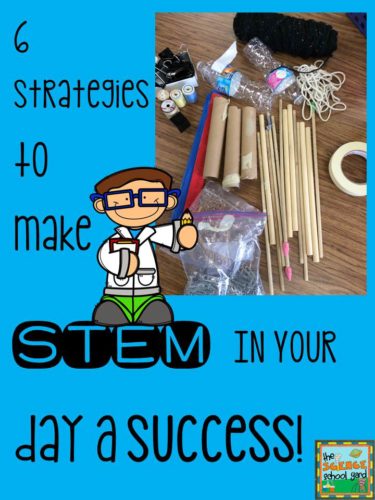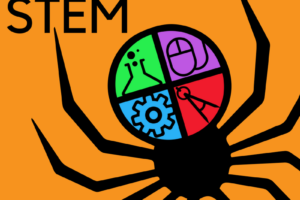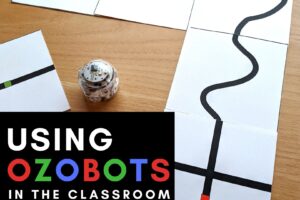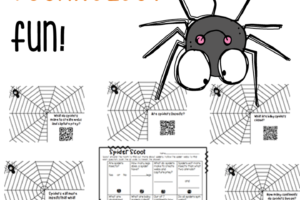How can you make STEM a part of your daily or weekly classroom routine? With all of the challenges facing teachers today, your plate is probably already pretty full. However, these strategies can help you conquer your fears!

Strategy 1: Organizing Your Supplies
Depending upon the STEM lesson I am teaching, I set up my supplies in two ways: all supplies on a tray ready to go, and supplies set up in a designated area that we call the “STEM Store”. This method allows for multiple choice making items to be placed out. The tray method allows for teams to have everything they need right at their finger tips.
Strategy 2: Pose a Real World Question
Knowing why they are building and creating something is important and allows for students to have a scenario to real world problems. Questions using your science standards or NGSS is a great starting point. Here are just a few examples I have used in my classroom using NGSS:
- A storm is coming to your town. You have only a small amount of time to build a shelter from the storm. Using the items at the STEM store can you build a shelter that has a room, walls, and door and can withstand a strong storm? 3-ESS3-1. Make a claim about the merit of a design solution that reduces the impacts of a weather-related hazard. ( I do different things to different groups: one group gets a snow storm, flood, wind, and one gets rain)
- It is really hot in the summer. Your parents always tell you to put sun screen on. You forget your sunscreen and it is really hot and sunny outside. You don’t want to get a sunburn. You decide to find cover or shade but there really isn’t any. K-PS3-2. Use tools and materials to design and build a structure that will reduce the warming effect of sunlight on an area. When your done a lamp will be used to represent the sun.
- I love my little stuffed animals. They are so cute. Using my Beanie Babies, can you create a vehicle for them using the supplies given that will allow me to push and pull it back and forth with you? When you are done making something for them let’s test it out. K-PS2-1. Plan and conduct an investigation to compare the effects of different strengths or different directions of pushes and pulls on the motion of an object.
Strategy 3: Add Questioning Vocabulary
Using scientific terminology allows for students to accurately use those words to communicate effectively and to connect math and science vocabulary to everyday activities.
Here are some Tier 2 and 3 Science vocabulary words to help you on your way:
-design
-observe
-develop
-integrate
-modify
-model
-explore
-constraints
-conduct
-maintain
Strategy 4: Use Picture Books To Springboard STEM Lessons
Finding great picture books that you are already using in language arts or in other subject matters will help make valuable connections that can go along way with your students. Making text to text, text to self, and text to world connections through STEM lessons can help remove the fear of failure due to background knowledge. It can create teamwork in groups because it evens the playing field and it can also allow all students an active role in problem solving!
Strategy 5: Use the Design Process to Guide You
Using the Design Process will help you be a facilitator of your STEM lessons. As you develop a STEM activity you can use this method to guide you so that you don’t miss any important steps along the way.
Design Process:
1. Define the Problem
2. Conduct Research (this can be done whole group, as a team, or individually)
You can also use an anchor chart to display your found information.
3. Develop multiple ideas (this can also be done whole group or as a team. You can also allow time for individuals to problem solve and think on their own. Using a graphic organizer often helps the learner to know what to focus on when it is time to share out.)
4. Develop and Create a Prototype.
5. Test it. (This is when we share what we created with the class)
6. Evaluate. (I use another graphic organizer to foster questions and guide my learners.)
7. Redesign or modify. (During the development stage if mistakes are made or ideas are not effective I allow for modifications. That is part of the understanding that failure is part of learning. When we share out, we set up our environment that consists of sharing solutions with each other at the time we share. It is a great way to communicate with our classmates and give positive feedback! In our graphic organizer we leave room for how we would change what we did.)
Strategy 6: Find Innovative Resources
Finding innovative resources is within your fingertips. There are great blogs based on STEM and science such as https://scienceschoolyard.blogspot.com/ and http://www.getcaughtengineering.com/. Finding teachers that using STEM lessons daily can help you see what ideas and options you might have right in front of you. There are also great STEM educators right on this blog that can help you find ways to integrate STEM easily into your day: Brooke Brown from Thinking Outside the Box, Teachers Are Terrific teacher Carol Davis, as well as Meredith Anderson from Momgineer…our Home Schooling Guru to name just a few. STEM educators and their blogs can help guide you on your path to being STEM-tastic!
These 6 tips are sure to help make STEM in your day a success!




Leave a Reply
Your email is safe with us.